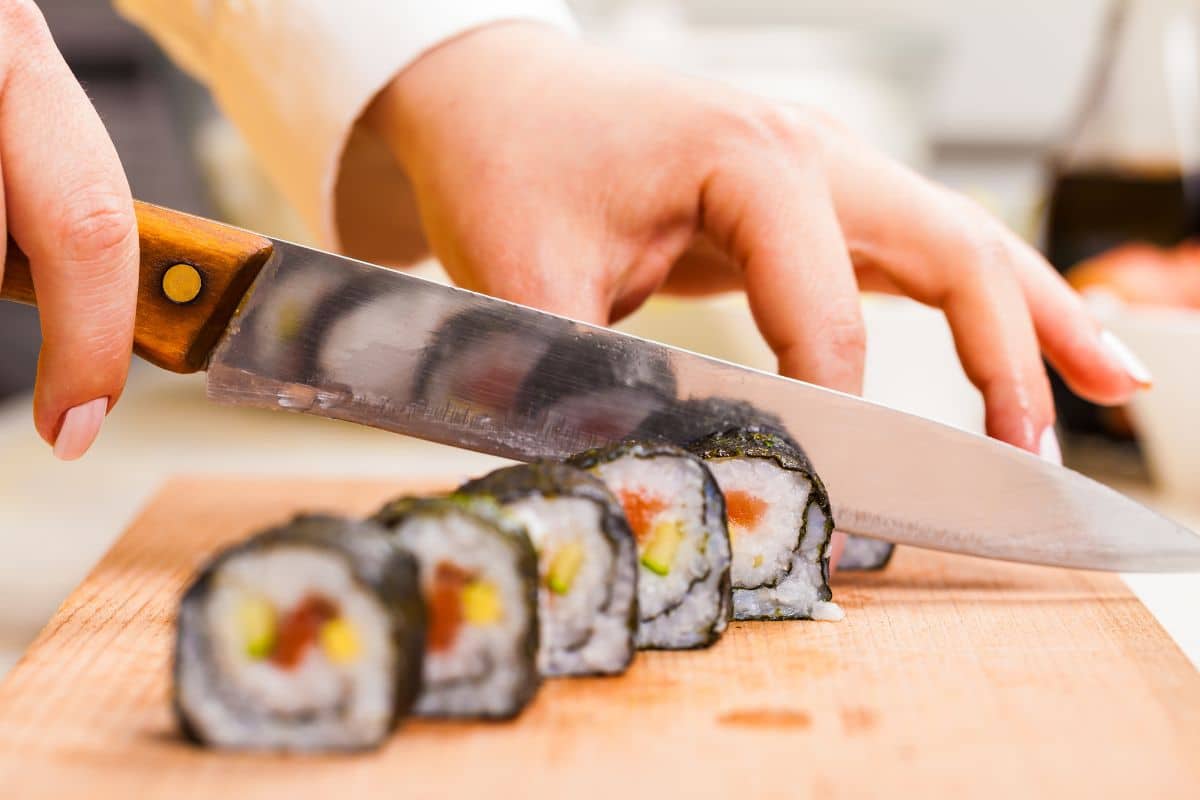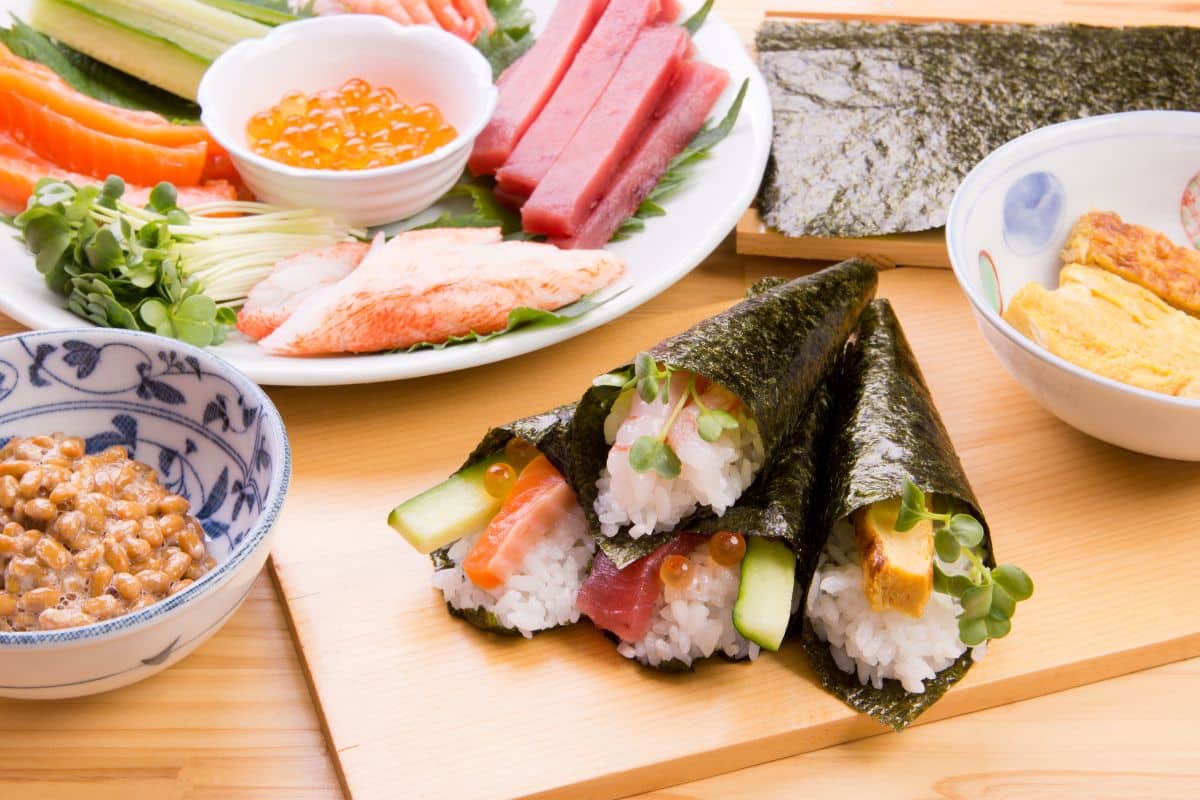Food Champs welcomes you to the ultimate sushi face-off between Cut Rolls and Hand Rolls! These are two of the most common forms in the sushi world, with millions of sushi lovers enjoying these rolls worldwide every day.

If you want to become a sushi connoisseur, you’ll need to know all about the differences and similarities between cut rolls and hand rolls.
Whilst both share many traits, there are a number of differences that can help you decide what type of roll you should get for your next sushi order.
Whether you’re a sushi lover or simply someone curious about the art of Japanese cuisine, you’ve come to the right place to find more about sushi.
In today’;s comprehensive guide, we’ll unravel the mysteries behind these two popular sushi styles, highlighting their key differences and shedding light on the unique experiences they offer.
Grab those chopsticks and join us as we explore the differences, and much more, between cut roll and hand roll sushi.
Difference Between Cut Roll And Hand Roll Sushi
The main difference between cut roll and hand roll sushi lies in their presentation and construction.
For instance, hand roll sushi, also known as temaki, is a cone-shaped roll created by wrapping a sheet of nori (seaweed) around a filling of rice, fish, vegetables, and other ingredients.
Regarded as a staple of the sushi world, cut rolls are typically enjoyed as a single-serving, handheld delicacy.
The unique shape of the hand roll allows for an interactive dining experience, with each bite offering a harmonious combination of flavors and textures.
On the other hand, cut roll sushi, also known as maki, is made by tightly rolling a sheet of nori within a bamboo mat and consists of layers of short-grain rice inside.
This rice is then typically treated with rice vinegar whilst toppings, such as fish, seafood, vegetables, cooked meats, and herbs are used. These bite-sized pieces offer a visually appealing presentation, showcasing the vibrant ingredients encased within the roll.
Cut Roll And Hand Roll Sushi – Shape
Cut rolls are meticulously crafted into cylindrical shapes, skillfully shaped using a bamboo mat to achieve flawless roundness.
Through precise pressure, the ingredients are evenly distributed from the center, ensuring a harmonious balance of flavors in every bite.
When it comes to hand rolls, the majority of these are conical (cone-shaped). This unique form not only allows for a secure grip, but also ensures that none of the tantalizing fillings escape, providing a mess-free and convenient sushi experience.
Cut Roll And Hand Roll Sushi – Names
A cut roll is also termed makizushi. “Maki” comes from “maku,” a Japanese word translating to “wrap” or “coil.” This is in reference to the roll’s distinctive tubular shape. “Zushi” stands for, you guessed it, “sushi.”
The majority of people call makizushi by other names, such as nori maki, maki, or makinori.
When it comes to hand rolls, these are also called “temaki,” but are also often referred to as temakizushi.
“Te” is Japanese for “hand,” whilst “maki” translated into “roll.” The term “temaki” literally translates to “hand roll.”
Cut Roll And Hand Roll Sushi – Flavors
The flavors of cut roll and hand roll sushi offer distinct taste experiences. Cut roll sushi tends to showcase a symphony of flavors in each bite-sized piece.
Its combination of nori, sushi rice, and various fillings creates a tasty blend with the overall flavor profile dictated by the fillings.
The flavors in cut rolls often meld together, allowing you to savor the different ingredients in a balanced manner.
Whether you’re enjoying the freshness of sashimi, the crunch of vegetables, or the umami of cooked fillings, each slice presents an eclectic mix of tastes.
Hand Roll Sushi offers a different kind of taste experience. These rolls typically present an exciting flavor journey, whilst their conical shapes allow for a unique taste sensation.
This starts with the crispness of nori followed by the softness of sushi rice and the vibrant flavors of the fillings.
As you make your way through a hand roll, the flavors unfold, creating a tasty mix that intrigues your taste buds.
Cut Roll And Hand Roll Sushi – Serving Sizes
The most common variety of cut roll sushi is Hosomaki makizushi. These are generally around eight inches in length and are made up of one full sheet of nori that is cut into either six or eight pieces.
All cut rolls measure around an inch in diameter, but there are larger examples, such as futomaki cut rolls. These typically include four or more ingredients and are usually cut into four pieces that have a diameter of around two inches on average.
Hand rolls tend to be smaller than their cut roll counterparts. The majority of restaurants serve hand rolls that are made from just half a sheet of nori, as opposed to the cut roll’s full sheet. These usually measure around 3.5 x 4 inches.
However, when cooked at home, many sushi chefs prefer to use a quarter sheet of nori. All in all, a single hand roll generally fills one portion size.
Cut Roll And Hand Roll Sushi – Ingredients/Fillings

In traditional Japanese sushi, cut rolls embrace simplicity, focusing on a selection of ingredients that enhance the neatly wrapped fish nestled within the nori.
Varieties such as yellowtail, salmon, tuna, whitefish, snapper, and eel typically take center stage, delicately enveloped by layers of nori and seasoned vinegared rice.
The exterior of these rolls is often adorned with a light coating of further ingredients, such as sesame seeds, roe, or masago. These help add subtle textures and flavors to the overall roll.
However, as sushi has evolved and crossed cultural boundaries, Westernized interpretations and more contemporary styles have been introduced. Many of these examples have introduced us to a wide array of ingredients and innovative filling techniques.
This has led to a diverse range of flavors and textures, with each layer intertwining with a sheet of seaweed and rice.
Modern sushi is at the hands of endless creativity and experimentation, resulting in tantalizing taste experiences.
Although cut rolls can be made with a variety of scrumptious fillings, hand rolls tend to incorporate a greater number of ingredients.
As we mentioned, hand rolls are most commonly made with four or more fillings and ingredients, leading to a burst of unique flavors.
There are many fillings you can use in hand rolls, from caviar and sashimi, to a variety of seafood, nagaimo, and egg. Some non-traditional fillings that have become increasingly popular include cooked beef, chicken, pork, and asparagus.
In other words, when you order or make a hand roll, you can get just about any filling you desire. The world is not your oysters# – the world is your hand rolls!
Cut Roll And Hand Roll Sushi – Difficulty To Make
When comparing the culinary difficulties between cut rolls and hand rolls, it’s hard to disagree that cut rolls are more challenging to roll.
This is because they are expertly rolled using a bamboo mat to form an even, tight maki roll packed to the brim with fillings. To make a perfect cut roll, it takes practice and a fair amount of skill.
Hand rolls tend to be much easier to roll tight when compared to preparing cut rolls. You don’t need much expertise or skill to make a hand roll, which is why these are more commonly made at home.
Even if you’re a complete novice, making temaki is a great place to start and a fun way to familiarize yourself with the delicacies of creating sushi rolls.
Cut Roll And Hand Roll Sushi – Ways To Eat
The overall shape, size, and cut of cut rolls mean they are best enjoyed with the use of chopsticks. These rolls are also quite large, so can be shared by a couple of people.
As the name suggests, hand rolls are meant to be eaten by hand. You don’t need any chopsticks or cutlery to enjoy these sushi rolls. And, because of their smaller size, hand rolls are designed to only feed one person at a time.
Cut Roll And Hand Roll Sushi – Varieties
Out of these two sushi rolls, cut rolls have far more varieties. That being said, they are generally classified into four fundamental sizes:
- Hosomaki – these are the smallest of cut rolls and only include one filling with rice. In general, these are very thin bite-sized pieces and measure up to an inch in diameter.
- Nakamaki – this cut roll is medium-sized and contains two to three fillings with rice. Their diameter, though, is only a little larger than Hosomaki.
- Chumaki – measuring around an inch and a half in diameter, Chumaki rolls are the second largest of cut rolls. These also include two to three fillings, but can contain four if rolled very tightly.
- Futomaki – finally, we have Futomaki, which are twice the size of Hosomaki (and sometimes even bigger). These are the largest of cut rolls and usually contain four or more fillings with rice and have a diameter of up to two and a half inches on average.
As well as these basic sizes, there are also a variety of maki types that correspond to the incorporated ingredients and/or the rolling technique used to make them. Some of these are:
- Kappamaki – made with cooked tuna and mayo.
- Tekkamaki – made with raw sushi-grade tuna.
- Nattomaki – made with fermented soybeans.
- Kappamaki – made with cooked tuna and mayo.
- Shinkomaki – made with radishes (pickled yellow daikon).
- Nattomaki – made with fermented soybeans.
- Uramaki – also known as “inside-out sushi roll,” Uramaki refers to how the roll is made backward using nori on its inside and rice on its outside.
- Kanpyomaki – these represent the traditional Edomae-zushi, a style of sushi that features veggies, marinated raw fish, and shellfish, accompanied by ingredients, such as dried ripe marinated gourd, mirin (sweet rice wine), and minced prawn.
The list of hand roll varieties is much shorter. In general, hand rolls list all ingredients or can be available as a substitute for a certain type of cut roll. This means they often come with the same fillings as the maki.
In most cases, whatever ingredients you find in a cut roll, you’ll also find in a hand roll.
Unlike cut rolls, though, hand rolls are often made with non-traditional ingredients and fillings, including marinated cooked meat and vegetables not associated with the eastern regions of the world, such as avocados and peas.
Cut Roll And Hand Roll Sushi – Comparison Table
| Cut Roll | Hand roll | |
| Shapes | Cylindrical/tubular | Cone-shaped (conical) |
| Names | Cut Roll, Makizushi, Makinori, Maki, and Nori Maki | Hand Roll and Temakizushi |
| Flavors | A combination of flavors based on the ingredients | Vibrant flavors, also based on the fillings. |
| Serving Sizes | Larger – around eight inches with six to eight pieces | Smaller – a single roll measuring around eight inches in diameter |
| Ingredients/Fillings | Basic fillings – seafood in vinegared rice and nori | More filling are possible (just about anything) |
| Difficulty to make | Very difficult – expertise needed to roll suing a sushi mat | Very easy – perfect for sushi novices |
| Ways to eat | Between two people using chopsticks | Only one person by hand |
| Varieties | Categorized by traditional varieties, size (small, medium, and large), and rolling technique | Traditional and non-traditional recipes can be sued |
Nutritional Content Breakdown: Which One Is Healthier?
Cut Roll Nutrition
The nutritional content of cut roll sushi can vary depending on the specific ingredients used and the size of the roll.
Here is the nutritional breakdown of six pieces of yellowtail cut roll sushi:
- Calories – 184
- Carbohydrates – 27 g
- Fat – 2 g
- Protein – 12 g
Hand Roll Nutrition
Again, the nutritional content of hand rolls depends on the fillings and ingredients used, as well as its size.
Here is the nutritional breakdown of a salmon hand roll (179 g):
- Calories – 162
- Carbohydrates – 16 g
- Fat – 6.3 g
- Protein – 10 g
Determining whether cut roll or hand roll sushi is healthier depends on various factors such as the specific ingredients, portion sizes, and individual dietary needs. The main factor is the fillings used. The healthier your roll’s ingredients are, the healthier the roll will be.
In Summary
Cut rolls and hand rolls share some similarities, but their main differences lie in the ingredients used and their sizes. Which one will you try today? We’re hungry, so we’re off for a large cut roll!







